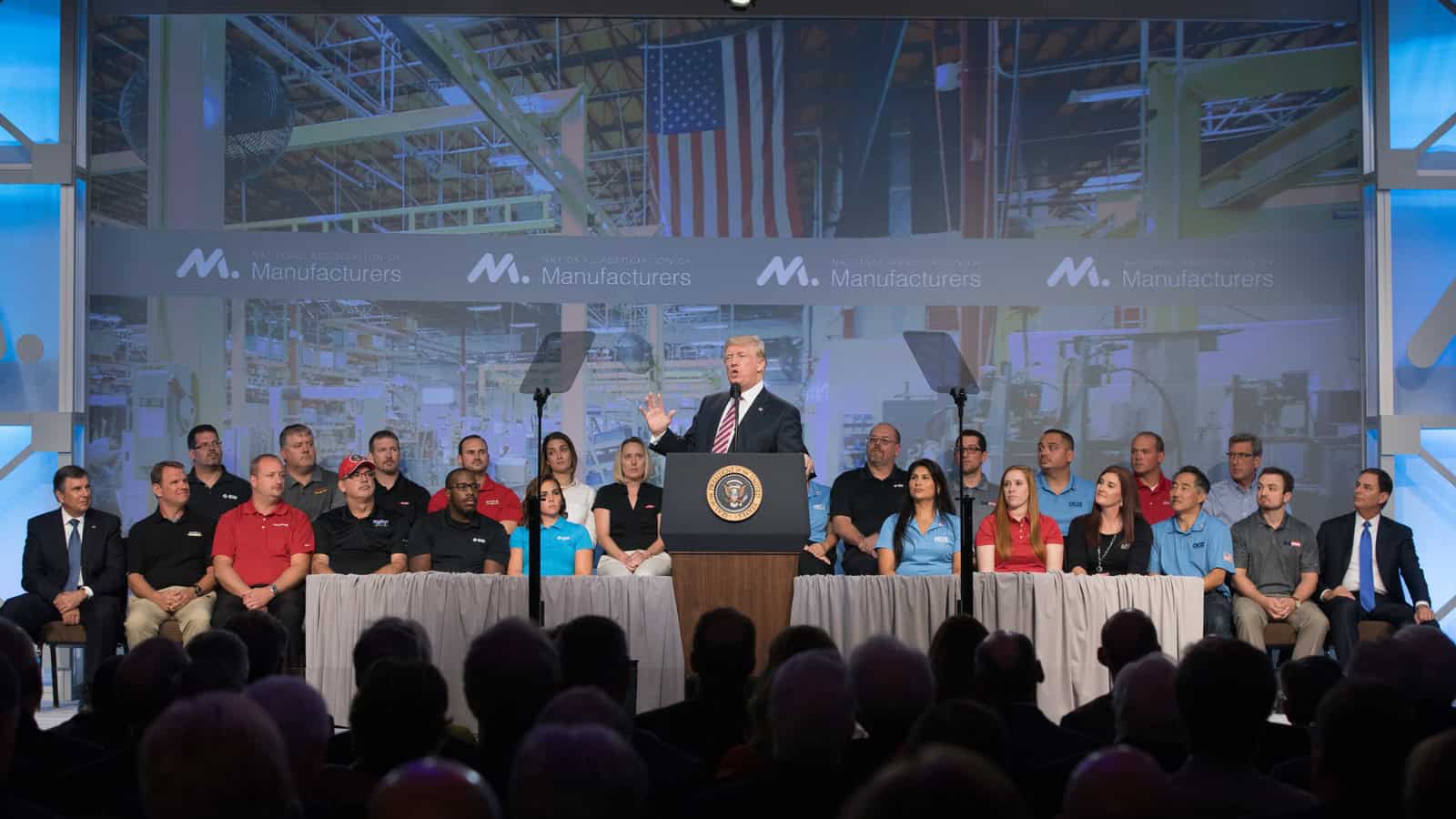Trump’s First Term: A Historic Era for Manufacturing

President Trump’s first term delivered significant wins for manufacturing in the United States, from tax reform to a regulatory overhaul to new trade agreements. Now, as the president-elect gears up for a second term, we look back on the transformational achievements and the NAM’s role in shaping policies that revitalized manufacturing in the U.S.
“Rocket fuel”: President Trump took the stage at the NAM’s board meeting in September 2017, where he laid out his tax reform agenda, describing it as “rocket fuel” for the U.S. economy. This was no ordinary policy effort—it was a generational initiative that would reshape industry in the United States.
- The impact: The Tax Cuts and Jobs Act delivered a 21% corporate tax rate while instituting full and immediate expensing for capital investments, improved interest deductibility and provided other critical provisions for small manufacturers and the entire industry.
- As a result, manufacturers nationwide reported record optimism, expanded operations, hired more workers, increased wages and benefits and reinvested in their communities.
Regulatory certainty: Recognizing that excessive regulations were stifling growth, the Trump White House asked then-NAM Board Chair David Farr in the first half of 2017 to compile a report from NAM members on the regulations causing them the most harm. The NAM team worked closely with administration leaders to address these pain points, compiling a list of 158 regulations for reform, with an emphasis on regulatory predictability and simplicity.
- The impact: By the close of Trump’s first term, more than 90% of the NAM’s regulatory recommendations were addressed or nearing completion. This unprecedented relief helped manufacturers focus on growth, product innovation and expansion.
Stronger deals: The Trump administration kept manufacturers and the NAM at the table, forging a trilateral deal to strengthen manufacturing’s competitive edge.
- The impact: Thanks in large part to manufacturers’ persistent advocacy work with lawmakers on Capitol Hill, the United States–Mexico–Canada Agreement was signed into law, restoring trade certainty for the North American markets that support millions of manufacturing jobs in the United States.
- While the NAM continues to pressure Mexico and Canada to live up to their commitments, the agreement strengthened businesses in the U.S. by ensuring updated trade standards, bolstering protections for intellectual property and digital trade and enhancing cooperation among North American partners.
Energy independence: Under President Trump’s administration, the NAM advanced an all-of-the-above energy strategy that included expanded domestic energy production and efficiency efforts. The NAM partnered with the Environmental Protection Agency and the Department of Energy to promote practices that both protected the environment and advanced innovation for a sustainable future.
- The impact: As former Trump EPA Administrator Andrew Wheeler pointed out recently at NAM headquarters in Washington, the rollback of restrictive energy regulations and the decision to maintain workable standards empowered manufacturers to increase domestic energy production, which reduced costs and bolstered energy independence.
- This balanced approach allowed manufacturers to meet consumer demand, strengthen supply chains and make greater contributions to America’s economy and environmental stewardship.
Safeguarding American IP: Confronting unfair trade practices with China was another priority. In 2019, the NAM worked closely with the White House to secure the “phase one” trade deal with China, which was designed to strengthen protections for American IP and help level the playing field for manufacturers in the U.S.
- The impact: The agreement established enforceable trade standards with China, aiming to protect U.S. innovations and support American jobs.
Operation Warp Speed: As the COVID-19 pandemic unfolded, manufacturers were at the forefront of the response. The NAM and its members partnered with the Trump administration to secure essential operations activity to implement Operation Warp Speed, a public–private partnership that fast-tracked the development, manufacturing and distribution of vaccines.
- The impact: Operation Warp Speed delivered lifesaving vaccines in record time, saving millions of lives, ending the global pandemic and demonstrating the unequaled capacity of American innovation and manufacturing.
Dignity of work: To address the skills gap, the Trump White House created the American Workforce Policy Advisory Board, naming NAM President and CEO Jay Timmons a member. Alongside other manufacturing leaders, and with the support of the NAM’s workforce development and education affiliate, the Manufacturing Institute, Timmons worked with the administration to elevate manufacturing careers and expand access to training. In a key event, the NAM and Ivanka Trump, who received the Alexander Hamilton Award for her leadership in championing manufacturing, launched the Creators Wanted Tour in 2020 to inspire the next generation of manufacturers and close the skills gap.
- The impact: Creators Wanted became the largest industry campaign to build excitement about modern manufacturing careers, highlighting the industry’s high-tech, well-paying jobs and reinforcing its role in supporting the American Dream. The campaign helped shift parents’ positive perception of manufacturing careers from 27% to 40% and signed up more than 1.5 million students and career mentors to learn more about manufacturing careers.
Bottom line: “President Trump’s first term reshaped what’s possible for manufacturing in the United States,” said NAM Executive Vice President Erin Streeter. “As he prepares to lead again, manufacturers have the benefit of building on a strong foundation with the president-elect as well as the purpose and pride that the industry brings out in lawmakers on both sides of the aisle.”
